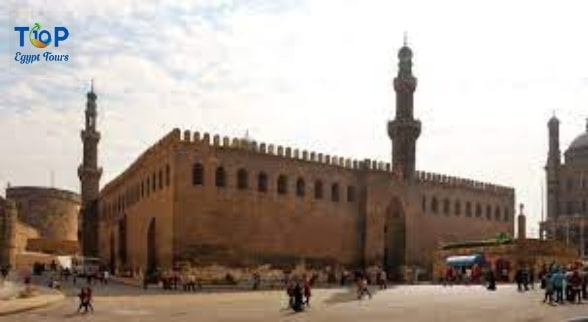Al-Nasir Muhammad Mosque also known as the Qalawun Complex, is a historic architectural masterpiece located in Cairo, Egypt. This complex, built during the Mamluk era, is a testament to the rich cultural and architectural heritage of Egypt. The Qalawun Complex comprises a mosque, a madrasa (Islamic school), a mausoleum, and other auxiliary buildings. It stands as a symbol of the artistic and architectural prowess of the Mamluk period and serves as an important religious and cultural landmark in Cairo.
In this article, we will uncover for you the Al-Nasir Muhammad Mosque with Top Ten Egypt.
Architectural Marvel Of Al-Nasir Muhammad Mosque:
The Qalawun Complex is renowned for its stunning architecture, which reflects the distinct Mamluk style. The mosque features intricate geometric patterns, ornate calligraphy, and delicate marble and stone carvings. The minaret, with its elegant design and height, stands as a prominent feature of the complex. The interior of the mosque is adorned with beautiful mosaics, stained glass windows, and intricately carved wooden details, creating a serene and awe-inspiring atmosphere.
Religious Significance:
Sultan al-Nasir Muhammad Mosque within the Qalawun Complex serves as an important place of worship for Muslims in Cairo. It is not only a religious center but also a place where the community gathers for Friday prayers and other religious occasions. The mosque’s spacious prayer hall can accommodate a large number of worshippers, and its serene ambiance provides a tranquil space for spiritual reflection and devotion.
Historical and Cultural Importance:
Al-Nasir Muhammad Mosque holds great historical and cultural significance. It was constructed in the 14th century during the reign of Sultan Al-Nasser Mohammed Ibn Kalawoun, one of the prominent Mamluk rulers. The complex served as a center for religious education, with the madrasa providing instruction in various Islamic sciences. The mausoleum within the complex houses the tombs of Sultan Al-Nasser Mohammed Ibn Kalawoun and his sons, further adding to its historical importance.
Tourist Attraction:
The Qalawun Complex is not only a place of worship but also a popular tourist attraction. Its stunning architecture, rich history, and cultural significance draw visitors from around the world. Tourists can explore the mosque by arranging an Islamic Cairo tour, admire its intricate details, and learn about the Mamluk era and its contributions to Islamic art and architecture. The complex’s central location in Cairo also makes it easily accessible to visitors.
Conclusion:
The Al-Nasser Mohammed Ibn Kalawoun Mosque, part of the Qalawun Complex, stands as a testament to Egypt’s rich architectural and cultural heritage. Its stunning design, historical significance, and religious importance make it a must-visit destination for tourists and a cherished place of worship for the local community. The preservation and restoration efforts ensure that this architectural marvel continues to inspire awe and appreciation for generations to come.



Comment (0)